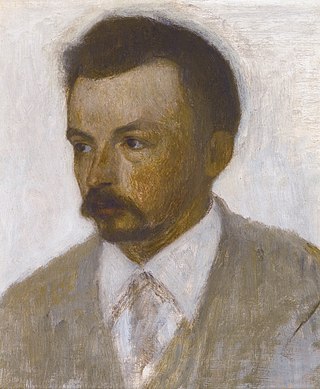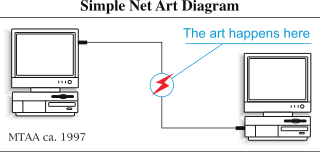Related Research Articles

The Ikon Gallery is an English gallery of contemporary art, located in Brindleyplace, Birmingham. It is housed in the Grade II listed, neo-Gothic former Oozells Street Board School, designed by John Henry Chamberlain in 1877.
Rachel Harrison is an American visual artist known for her sculpture, photography, and drawing. Her work often combines handmade forms with found objects or photographs, bringing art history, politics, and pop culture into dialogue with one another. She has been included in numerous exhibitions in Europe and the US, including the Venice Biennale, the Whitney Biennial and the Tate Triennial (2009). Her work is in the collections of major museums such as The Museum of Modern Art, New York; Metropolitan Museum of Art, New York; Hirshhorn Museum and Sculpture Garden, Washington, D.C.; and Tate Modern, London; among others. She lives and works in New York.
Tom Palin is a British painter.

Vilhelm Hammershøi, often anglicised as Vilhelm Hammershoi, was a Danish painter. He is known for his poetic, subdued portraits and interiors. In 1905, Rainer Maria Rilke wrote of the artist, "Hammershøi is not one of those about whom one can speak quickly. His work is wide-ranging and slow, and at whatever moment one comprehends it, it will always provide an opportunity to talk about what is important and essential in art".

Brian Wood is a visual artist working in painting, drawing and printmaking and formerly with photography and film in upstate New York and New York City.
Sociological Art is an artistic movement and approach to aesthetics that emerged in France in the early 1970s and became the basis for the Sociological Art Collective formed by Hervé Fischer, Fred Forest, and Jean-Paul Thenot in 1974.

The Government Art Collection (GAC) is the collection of artworks owned by the UK government and administered by the Department for Culture, Media and Sport (DCMS). The GAC's artworks are used to decorate major government buildings in the UK and around the world, and to promote British art, culture and history. The GAC now holds over 14,000 works of art in a variety of media, including around 2,500 oil paintings, but also sculpture, prints, drawings, photographs, textiles and video works, mainly created by British artists or artist with a strong connection to the UK, from the sixteenth century to the present day. Works are displayed in several hundred locations, including Downing Street, ministerial offices and reception areas in Whitehall, regional government offices in the UK, and diplomatic posts outside the UK.
Rhizome is an American not-for-profit arts organization that supports and provides a platform for new media art.
The Professional Native Indian Artists Incorporation (PNIAI) was a group of First Nations artists from Canada, with one from the United States. Founded in November 1973, they were Indigenous painters who exhibited in the mainstream art world.

Internet art is a form of new media art distributed via the Internet. This form of art circumvents the traditional dominance of the physical gallery and museum system. In many cases, the viewer is drawn into some kind of interaction with the work of art. Artists working in this manner are sometimes referred to as net artists.
Samy D. is a Tel Aviv based ceramic artist.
Triple Canopy is a New York-based "magazine" and 501(c)(3) nonprofit organization. Issues of the "magazine" are published online over the course of several months. Each issue focuses on specific questions and areas of concern, and features works of art and literature, conversations, performances, exhibitions, and books. Triple Canopy is dedicated to “sustained inquiry, careful reading and viewing, resisting and expanding the present.” In “The Binder and the Server,” a memoir-manifesto published in 2010, the editors proclaimed their intention to “slow down the internet”; subsequently, reflecting on the erosion of the line between “online” and “offline,” they shifted to “slow down the world.” Triple Canopy is certified by Working Artists and the Greater Economy (W.A.G.E.). Triple Canopy’s archive was acquired by the Fales Library and Special Collection at New York University.

John Craig Freeman is a contemporary artist and a Professor of New Media at Emerson College in Boston.
Adelheid Mers is a German visual artist, Professor, and the Chair of the Department of Arts Administration and Policy at the School of the Art Institute of Chicago, Chicago, IL. As an artist, Mers works through Performative Diagrammatics, a practice that includes elements of installation, facilitation with publics, and video. Her research draws on close work with others, exploring arts ecologies, and knowing differently, or epistemic diversity. Work takes place nationally and internationally, for example in residency, conference and exhibition settings.
Karin Bubaš is a contemporary Canadian artist known for her work in various media including photography, painting, and drawing.
Henry Tsang is a contemporary Canadian artist.
Renée Van Halm is a Canadian contemporary visual artist born in Haarlemmermeer, the Netherlands (1949) and immigrated to Canada in 1953.

The Usher Gallery is an art museum in Lincoln, England. The gallery displays a collection of artworks by painters such as J. M. W. Turner and L. S. Lowry. Established in 1927, it is run as part of Lincoln Museum.
RaFia Santana is a non-binary American artist, musician, and performer based in Brooklyn, NY. Her work ranges from animated gifs to self-portraiture, videos, and performance to editioned clothing and electronic music exploring gentrification, the millennial mindset, mental health, and the lived black experience. They use the internet as a medium to share their artwork, empower black and brown communities, and challenge ideas of solidarity and alliance. She had exhibitions and/or performances at the Eyebeam, AdVerse Fest, SleepCenter, Times Square Arts, International Center of Photography, Schomburg Center for Research in Black Culture, Babycastles, Museum of the Moving Image and Museum of Contemporary African Disaporan Arts, Roots & Culture amongst many notable venues. Her work has been featured in publications such as Huffington Post, HyperAllergic, Rhizome, ArtFCity, Vogue, Teen Vogue and Salon. They have participated in panels, performances and discussions such as Cultured Magazine, "Late at Tate Britain", Creative Tech Week NYC, Afrotectopia at Google NYC, NYU, "Black Portraitures IV: The Color of Silence" at Harvard University and International Center for Photography. Their music is released through Never Normal Records.
David Marcel Levine is a theater professor and visual artist, currently a professor of the Practice of Performance, Theater, and Media at Harvard University.
References
- ↑ College Art Association (Producer). (2011, Jan 26). "Developing Your Artist Statement" [Audio Podcast]. Retrieved from http://www.collegeart.org/podcasts/
- ↑ Tom Palin: Artist Statements 1992-2012. Workshop Press Leeds, 2013.
- ↑ Detterer, Gabriele. Ed. Art Recollection: Artists' Interviews & Statements in the Nineties. Florence: Danilo Montanari, Exit, and Zona Archives Editori, 1997.
- ↑ Garrett-Petts, W.F., and Rachel Nash. "Re-Visioning the Visual: Making Artistic Inquiry Visible." Rhizomes 18 (Winter 2008). Spec. issue on "Imaging Place".
- ↑ "Triple Canopy – International Art English by Alix Rule & David Levine". Triple Canopy. Retrieved 2016-10-08.
- ↑ Beckett, Andy (2013-01-27). "A user's guide to artspeak". The Guardian. ISSN 0261-3077 . Retrieved 2016-10-08.